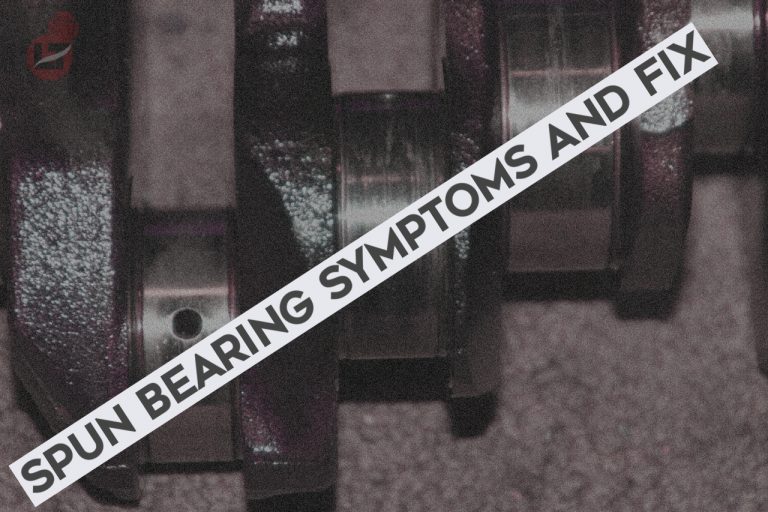Spun bearings can occur in any vehicle, including trucks, and are often the result of a series of unfortunate events such as high operating loads, excessive heat, or a lack of lubrication.
Also, a loss of oil pressure can lead to spun bearings, plus other factors that can contribute to the bearing seizing and spinning.
Continue reading to learn more about spun bearing.
Symptoms of Worn-Out Engine Bearings
Whenever your vehicle has a worn-out main engine bearing or rod bearing, it will begin to display some or all of the common symptoms:
1. Dirt on the bearing
When dirt particles find their way into the bearing and its housing, they can damage the bearing. The bearing and housing should have a thin layer of lubricating oil, but impurities will create an abrasive effect on the bearing surface, reducing its clearance with the housing. This issue can arise because the engine is not clean enough or because dirt is in the oil.
2. Knocking Noises
If you hear knocking noises when starting your car’s engine, it may indicate worn engine bearings that need replacement. This is one of the common symptoms of spun bearing.
3. Incorrect Assembly/Gradual Wear
Improper assembly in the engine can lead to the wearing down of the bearing, causing a spun bearing rod. Over time, loose installation of connecting rods or bearings can result in excessive clearance, noise, and damage.
4. Thin Oil
Using a low-viscosity oil can cause a spun bearing rod because it lacks the necessary pressure to separate the bearings from the housing surface. This issue becomes more pronounced when the engine is warm since the oil’s viscosity decreases with temperature.
5. Low Oil Pressure
Another symptom of a spun bearing is low oil pressure. When a bearing is beginning to fail or has already failed, it can cause a decrease in oil pressure, which is noticeable when you start the vehicle. In addition, a bad rod bearing can trigger a warning light on your dashboard that says, “Check engine oil.”
Spun Bearing Diagnosis
It is essential to know the necessary steps for spun-bearing diagnosing.
To diagnose spun bearing, you need to follow the steps below:
1. Plug Wire Removal
To identify the cylinder associated with the defective rod bearing, there is a method that involves opening the car hood and removing all the spark plug wires one by one. After removing each wire, turn on the engine and listen for any knocking sounds. If the sound disappears, it indicates that the cylinder from which the plug wire was removed has a faulty connecting rod bearing.
2. Visual Inspection
You don’t necessarily have to disassemble the engine to inspect the bearings visually for wear or damage. Start by raising the car’s front wheels with a jack and setting the parking brake.
Using a wrench, remove the long drainage bolt from the oil pan to drain the oil, ensuring a catch pan is in place to prevent spills. If the oil contains metal shavings, this could indicate bearing failure.
Next, remove the bolts surrounding the oil pan to access the bearings. Inspect them closely for any signs of damage or wear. If the bearings display scratches, discoloration, pitted surfaces, dirt buildup, or aren’t uniformly smooth, you may need to replace them.
FAQs
Does a spun bearing ruin the block?
YES, however, if you turn off the ignition before it gets critical and the parts hastily leave the crankcase, you can save the block.
Can a spun bearing Be Fixed?
If the damage is severe, replacing the crank, rods, pistons, and block is the best case for fixing a spun bearing.
What causes engine bearings to fail?
These two factors cause several engine bearing failures:
- Mixed lubrication with metal-to-metal contact between the bearing and crankshaft surfaces;
- Fatigue of the bearing material.
- Mixed lubrication is one of the causes of engine bearing failures.
What damage can a spun bearing do?
A typical engine problem is a spun rod bearing, which can cause extensive damage. A rod bearing spins can damage the big end taken in the rod, the rod journal on the crankshaft, and even break the connecting rod. This is terrible news, as a broken rod inside an engine can cause severe and costly damage.
How much does it cost to fix a spun bearing?
The average cost of repairing spun engine rod bearings is about $2,500 (parts plus labor). You’ll need to repair or replace parts like gaskets, cylinder head bolts, engine more excellent lines, pistons, crankshafts, and more.
As an Amazon Service LLC Program Associate, V. Auto Basics earns from qualifying purchases. See Our Affiliate disclaimer.
